Dyslexia Disease: Barriers to Learning and Intervention Strategies
Added on 2023-06-10
25 Pages7531 Words141 Views
Running head: DYSLEXIA DISEASE
Dyslexia Disease
Name of the Student
Name of the University
Author Note
Dyslexia Disease
Name of the Student
Name of the University
Author Note
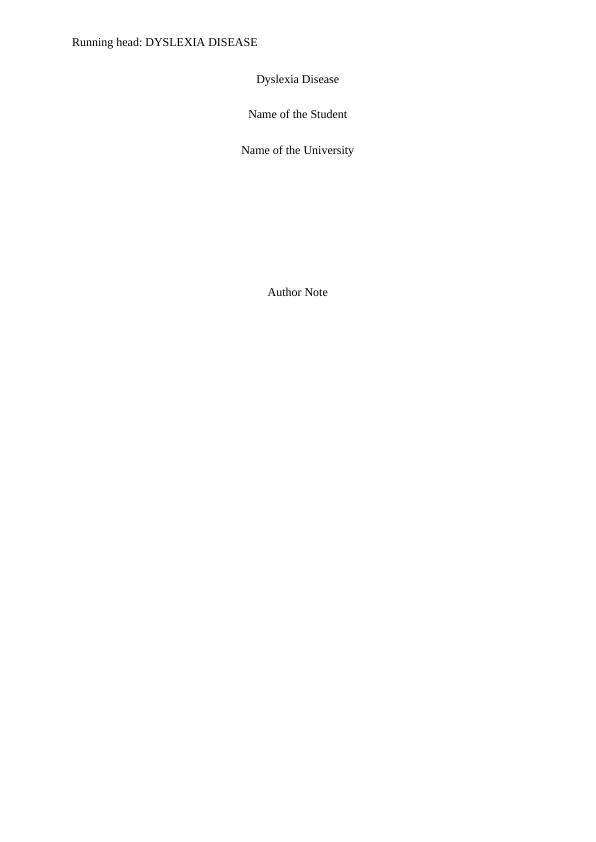
1DYSLEXIA DISEASE
Executive Summary:
The aim of this document is to evaluate the potential barriers faced by the dyslexic
students to learning. The dyslexia disease is a common disease in children in the United
Kingdom. Further, this assessment will critically analyse the challenges faced by a dyslexic
student and the impact of it on their holistic development. The challenges faced by a dyslexic
student will be sum up and will evaluate some intervention to support the dyslexic student in
their area of need. In the last section of this assessment, a short learning programme will be
discussed which will contain some strategies to remove the barriers to learning of the
dyslexic student.
Executive Summary:
The aim of this document is to evaluate the potential barriers faced by the dyslexic
students to learning. The dyslexia disease is a common disease in children in the United
Kingdom. Further, this assessment will critically analyse the challenges faced by a dyslexic
student and the impact of it on their holistic development. The challenges faced by a dyslexic
student will be sum up and will evaluate some intervention to support the dyslexic student in
their area of need. In the last section of this assessment, a short learning programme will be
discussed which will contain some strategies to remove the barriers to learning of the
dyslexic student.
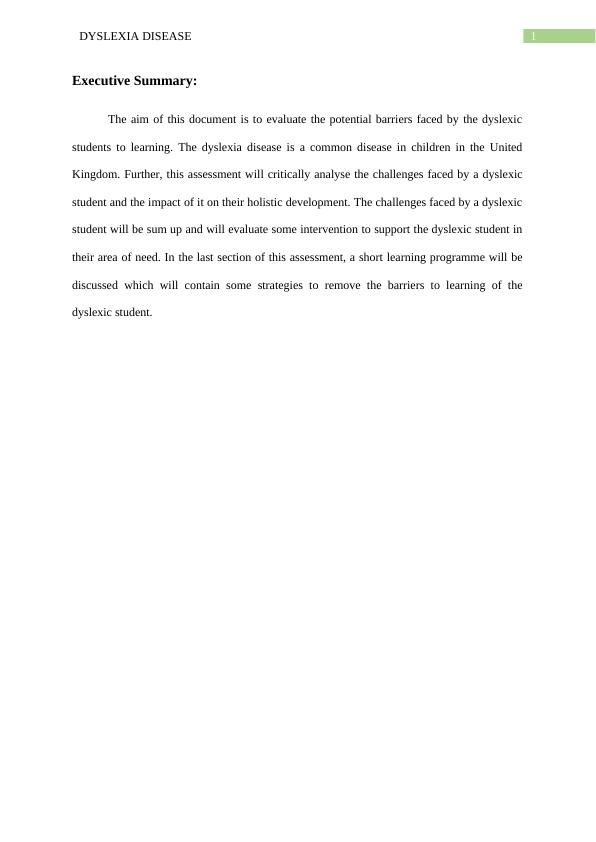
2DYSLEXIA DISEASE
Table of Contents
Assessment 1:.............................................................................................................................3
Introduction:...............................................................................................................................3
About Dyslexia:.........................................................................................................................4
Dyslexia Symptoms:..................................................................................................................4
1. Preschool:...........................................................................................................................5
2. Grade School:.....................................................................................................................5
3. Middle School:...................................................................................................................6
4. High School:.......................................................................................................................6
Reasons for Dyslexia:................................................................................................................6
1. Heredity:.............................................................................................................................6
2. Brain Anatomy:..................................................................................................................6
Diagnosis techniques of Dyslexia:.............................................................................................7
Potential Barriers to Learning:...................................................................................................7
1. Understanding:...................................................................................................................7
2. Identifying Key Points:......................................................................................................8
3. Handling Information:........................................................................................................8
Impact on the challenges of the holistic development:............................................................10
Evaluation of intervention:.......................................................................................................12
Assessment 2:...........................................................................................................................15
Conclusion:..............................................................................................................................18
References:...............................................................................................................................19
Table of Contents
Assessment 1:.............................................................................................................................3
Introduction:...............................................................................................................................3
About Dyslexia:.........................................................................................................................4
Dyslexia Symptoms:..................................................................................................................4
1. Preschool:...........................................................................................................................5
2. Grade School:.....................................................................................................................5
3. Middle School:...................................................................................................................6
4. High School:.......................................................................................................................6
Reasons for Dyslexia:................................................................................................................6
1. Heredity:.............................................................................................................................6
2. Brain Anatomy:..................................................................................................................6
Diagnosis techniques of Dyslexia:.............................................................................................7
Potential Barriers to Learning:...................................................................................................7
1. Understanding:...................................................................................................................7
2. Identifying Key Points:......................................................................................................8
3. Handling Information:........................................................................................................8
Impact on the challenges of the holistic development:............................................................10
Evaluation of intervention:.......................................................................................................12
Assessment 2:...........................................................................................................................15
Conclusion:..............................................................................................................................18
References:...............................................................................................................................19

3DYSLEXIA DISEASE
Assessment 1:
Introduction:
Dyslexia is a type of disorder in which the suffering child should have some type of
problem regarding the reading. It is also identified as a reading disorder. In such type of
cases, the student or the child might have the proper intelligence to learning something new,
but they will be unable to read in most of the cases (Ellis, 2016). There are more symptoms of
this disease which are, problems in spelling a word correctly, writing a word correctly and
speaking fluently. This type of disease often noticed first time at the school when the student
might face some difficulties to learn some basic things. It is believed that the dyslexia is
caused by some genetic issues. Dyslexia is one of the common learning issues, and it can
appear in both male and females. Though dyslexia is a type of learning disorder, it has no
connection with the intelligence of the children. Dyslexia is non-curable disease and can
affect all the people belongs from the cultural background (Knowles, 2017). Dyslexia is non-
curable means not that the students or the child cannot succeed in their life. For example,
there are many famous personalities with the dyslexia disease. In this assessment, a brief
about dyslexia disease will be discussed, and the main aspects of dyslexia will be highlighted.
Further, in this assessment dyslexia symptoms, causes of dyslexia, potential barriers to
learning will be discussed. Also, the paper will critically analyse the challenges faced by the
dyslexic child and will help the children by evaluating the support need by the student. In the
end, this paper will discuss some steps to overcome the barriers to learning for dyslexic
students.
Assessment 1:
Introduction:
Dyslexia is a type of disorder in which the suffering child should have some type of
problem regarding the reading. It is also identified as a reading disorder. In such type of
cases, the student or the child might have the proper intelligence to learning something new,
but they will be unable to read in most of the cases (Ellis, 2016). There are more symptoms of
this disease which are, problems in spelling a word correctly, writing a word correctly and
speaking fluently. This type of disease often noticed first time at the school when the student
might face some difficulties to learn some basic things. It is believed that the dyslexia is
caused by some genetic issues. Dyslexia is one of the common learning issues, and it can
appear in both male and females. Though dyslexia is a type of learning disorder, it has no
connection with the intelligence of the children. Dyslexia is non-curable disease and can
affect all the people belongs from the cultural background (Knowles, 2017). Dyslexia is non-
curable means not that the students or the child cannot succeed in their life. For example,
there are many famous personalities with the dyslexia disease. In this assessment, a brief
about dyslexia disease will be discussed, and the main aspects of dyslexia will be highlighted.
Further, in this assessment dyslexia symptoms, causes of dyslexia, potential barriers to
learning will be discussed. Also, the paper will critically analyse the challenges faced by the
dyslexic child and will help the children by evaluating the support need by the student. In the
end, this paper will discuss some steps to overcome the barriers to learning for dyslexic
students.
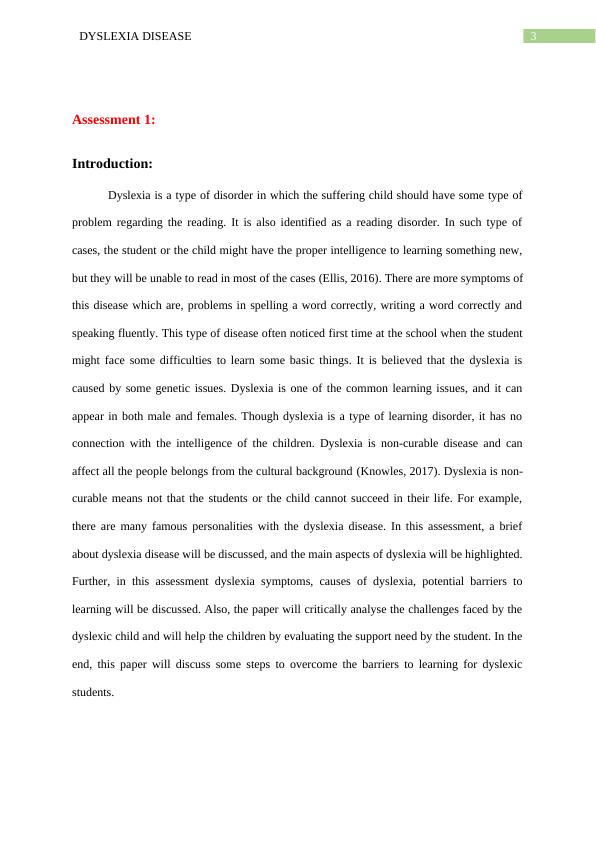
4DYSLEXIA DISEASE
About Dyslexia:
Dyslexia is a particular type of a learning disability which can be seen in the early
stage of development of the kids. Dyslexia affected child or student face trouble in reading
learning some new things. They also face problems while writing and spelling something.
The main difficulty faced by dyslexia affected student is the reading, which is becoming the
main barrier in the learning process (Alsobhi, Khan & Rahanu, 2014). It is the most common
learning issue which is faced by the students. From recent researches, it has been found that
about 10 percent of the child in the United Kingdom is affected by the dyslexia disease
(Warmington, Stothard & Snowling, 2013). Dyslexia affected people have problems with
answering something that they have already read, but it is possible for them to remember the
lesson in a different way of learning. Though there are many barriers to learning of dyslexia
affected student, there are many ways that can help the student to succeed in their early
education life.
Some people believe that the dyslexia is a visual related issue and the students
affected by it reverse the letters and can also write backwards, but this concept is wrong.
Dyslexia affected student or child does not have any problem with their vision or problems
like visualising the letters in a wrong direction. It needs to be understood that dyslexia
affected people have problems reading comprehensive texts but they have no problems with
their intelligence (Frith, 2017). Dyslexia affected child cannot be cured of it, but teaching in
an appropriate style can help the child to overcome the challenges.
Dyslexia Symptoms:
Dyslexia affected peoples have various degrees of impacts. It can vary for different
peoples. The basic problems of every dyslexia student are in the reading and in spelling the
words. In some critical cases, this disease can impact the writing skills, math solving skills
About Dyslexia:
Dyslexia is a particular type of a learning disability which can be seen in the early
stage of development of the kids. Dyslexia affected child or student face trouble in reading
learning some new things. They also face problems while writing and spelling something.
The main difficulty faced by dyslexia affected student is the reading, which is becoming the
main barrier in the learning process (Alsobhi, Khan & Rahanu, 2014). It is the most common
learning issue which is faced by the students. From recent researches, it has been found that
about 10 percent of the child in the United Kingdom is affected by the dyslexia disease
(Warmington, Stothard & Snowling, 2013). Dyslexia affected people have problems with
answering something that they have already read, but it is possible for them to remember the
lesson in a different way of learning. Though there are many barriers to learning of dyslexia
affected student, there are many ways that can help the student to succeed in their early
education life.
Some people believe that the dyslexia is a visual related issue and the students
affected by it reverse the letters and can also write backwards, but this concept is wrong.
Dyslexia affected student or child does not have any problem with their vision or problems
like visualising the letters in a wrong direction. It needs to be understood that dyslexia
affected people have problems reading comprehensive texts but they have no problems with
their intelligence (Frith, 2017). Dyslexia affected child cannot be cured of it, but teaching in
an appropriate style can help the child to overcome the challenges.
Dyslexia Symptoms:
Dyslexia affected peoples have various degrees of impacts. It can vary for different
peoples. The basic problems of every dyslexia student are in the reading and in spelling the
words. In some critical cases, this disease can impact the writing skills, math solving skills
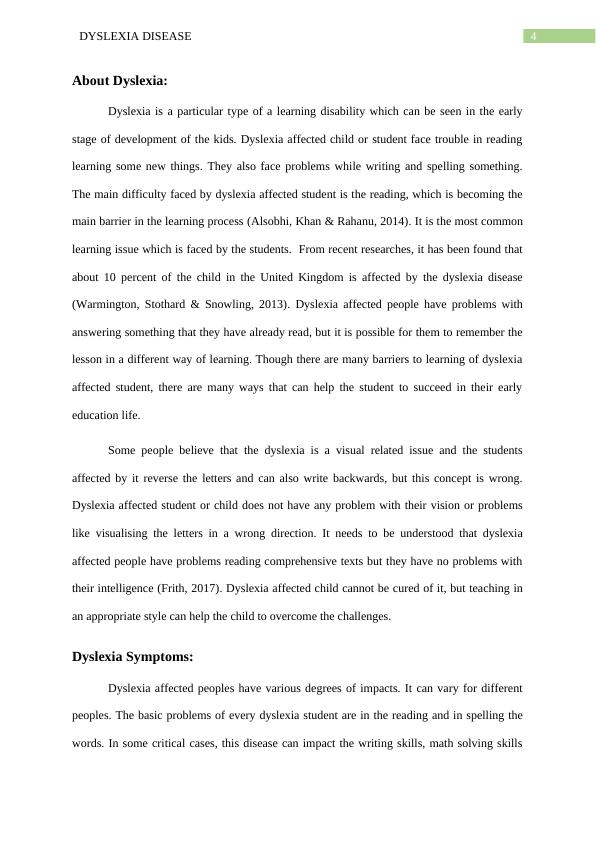
5DYSLEXIA DISEASE
and fluency in speaking a language (Evans et al., 2014). Another problem related to dyslexia
is the decoding the words. This type of problem arises because they struggle with their
general speaking skills. These problems can be seen at the preschool level of the student. This
is the first stage where dyslexia can be determined. Dyslexia can be determined later on when
students have problems with some complex skills like solving math, using proper grammars
and reading comprehension. Also, the dyslexic student omits the sound or letters when they
reading or writing. They face the big confusion of right and left for a sentence (Stein, 2017).
A severe headache is also reported with the students having the dyslexia disease. The
dyslexic students find difficulty to follow sequenced instructions. Many times this issue
considered as a visual problem but the dyslexic students face such type of problem which is
the pages of the book or screen appears too blurry to them (Bellocchi, 2013). One of the
common symptoms is that they are not able to differentiate between various types of speech
sounds. They fail to pronounce a word in a correct way. The dyslexic students also face some
problems while using any kind of writing tools like pen and pencils. They might frustrate
while reading even after they are able to read texts with fluency. In the following section,
some example of dyslexia is discussed in different levels.
1. Preschool:
A problem in rhyme recognition.
Struggling to speak the first word of a sentence.
A problem in learning new words.
Problems in reading a text loudly.
2. Grade School:
Problems in recognizing common sight words.
Quickly forgetting the issue after reading something.
Facing word problems in mathematics.
and fluency in speaking a language (Evans et al., 2014). Another problem related to dyslexia
is the decoding the words. This type of problem arises because they struggle with their
general speaking skills. These problems can be seen at the preschool level of the student. This
is the first stage where dyslexia can be determined. Dyslexia can be determined later on when
students have problems with some complex skills like solving math, using proper grammars
and reading comprehension. Also, the dyslexic student omits the sound or letters when they
reading or writing. They face the big confusion of right and left for a sentence (Stein, 2017).
A severe headache is also reported with the students having the dyslexia disease. The
dyslexic students find difficulty to follow sequenced instructions. Many times this issue
considered as a visual problem but the dyslexic students face such type of problem which is
the pages of the book or screen appears too blurry to them (Bellocchi, 2013). One of the
common symptoms is that they are not able to differentiate between various types of speech
sounds. They fail to pronounce a word in a correct way. The dyslexic students also face some
problems while using any kind of writing tools like pen and pencils. They might frustrate
while reading even after they are able to read texts with fluency. In the following section,
some example of dyslexia is discussed in different levels.
1. Preschool:
A problem in rhyme recognition.
Struggling to speak the first word of a sentence.
A problem in learning new words.
Problems in reading a text loudly.
2. Grade School:
Problems in recognizing common sight words.
Quickly forgetting the issue after reading something.
Facing word problems in mathematics.
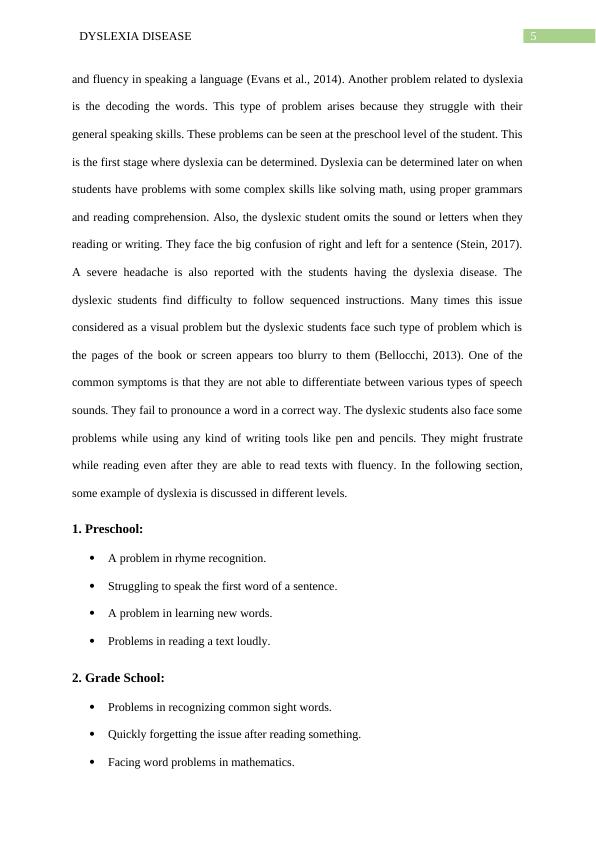
End of preview
Want to access all the pages? Upload your documents or become a member.
Related Documents
Dyslexia: Understanding, Education, and Supportlg...
|13
|743
|38
Effectiveness of Instructional Activities for Improving Reading Skills of Dyslexic Studentslg...
|7
|1488
|455
Applied Research Project: Dyslexialg...
|14
|3871
|34
Article on Dyslexia Diseaselg...
|6
|1219
|23
Dyslexia Specialists in Higher Education (Doc)lg...
|7
|1985
|434
Long term outcomes for children with learninglg...
|6
|1460
|12